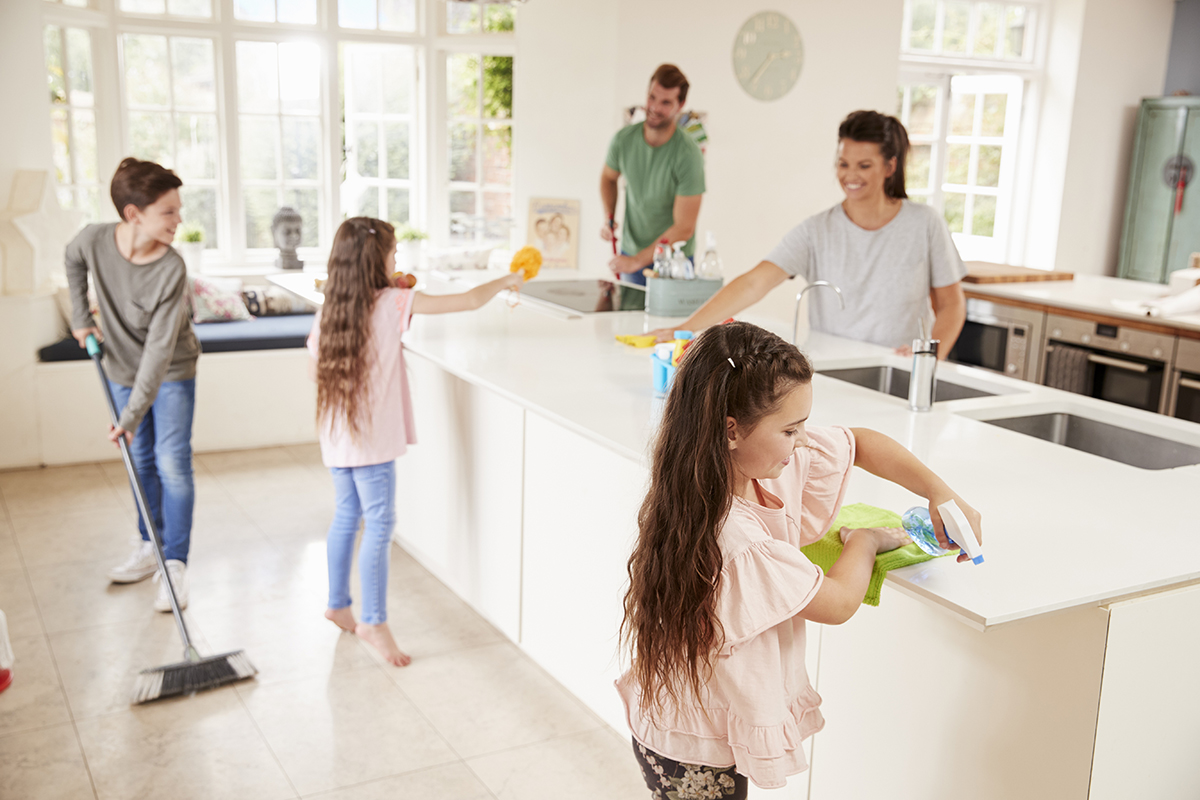A Teething Chart is a guide that outlines when different types of a baby’s teeth erupt.
It shows the approximate age at which parents should expect their baby’s teeth to emerge and the order in which these teeth develop.
In a baby’s first year of existence, there are many milestones that parents look forward to, and the emergence of the baby’s first tooth or teeth is one of them. Most parents want to be prepared for this development because teething can, in some cases, be associated with frustration. For instance, symptoms such as crying, irritability, increased drooling, reduced appetite for solid food, and low-grade temperature.
They, therefore, use teething charts to determine when the baby’s first teeth are likely to emerge and the order in which the rest of the teeth will emerge. This way, parents can provide care for the baby during the transition phases.
tip
Knowing a baby’s first tooth emergence period helps parents prepare and develop healthy oral care habits. A baby is born with 20 teeth already under their gum, which erupt to be deciduous or primary teeth.
Baby Teething Charts
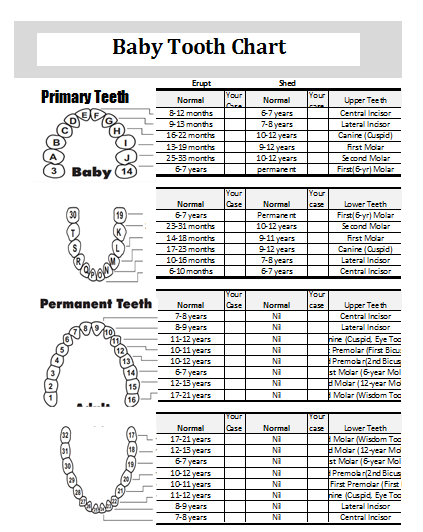
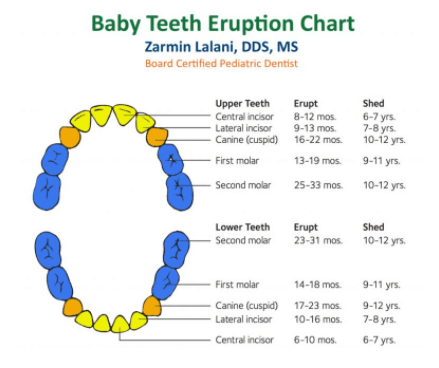
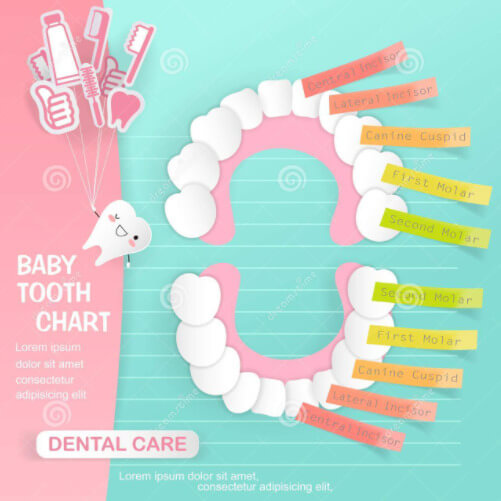
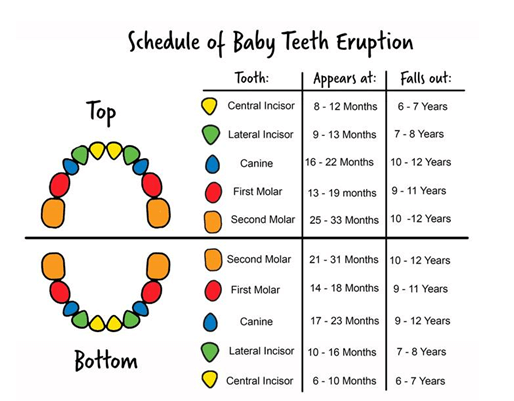
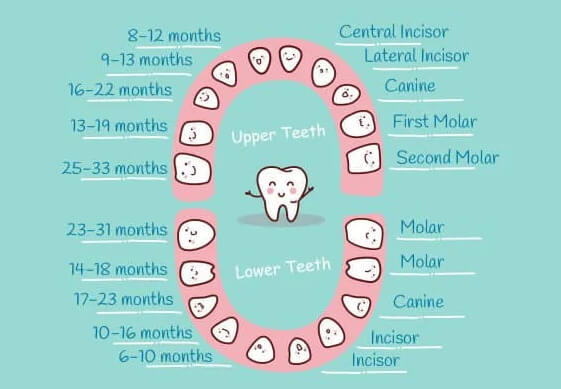
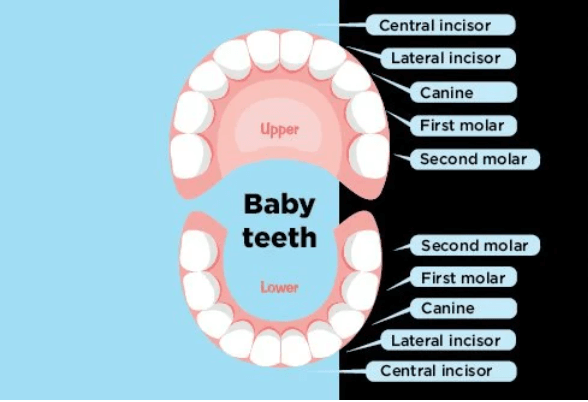
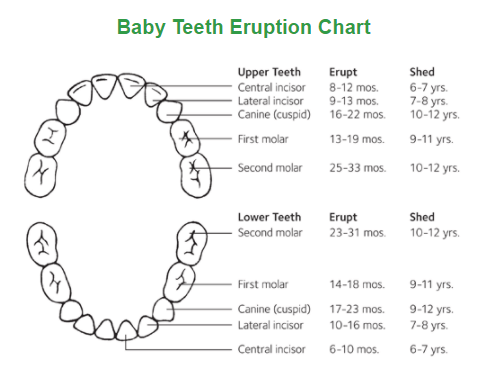
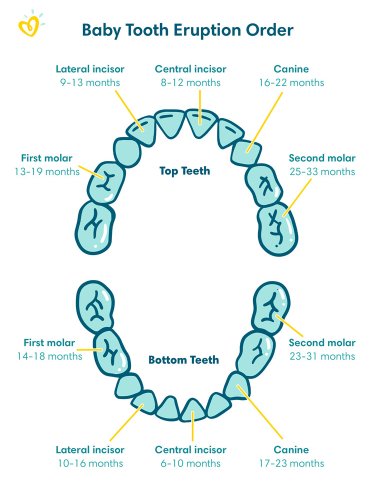
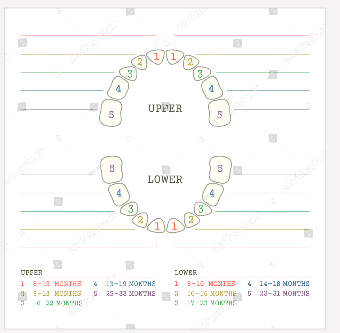
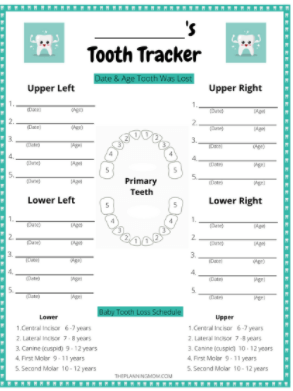
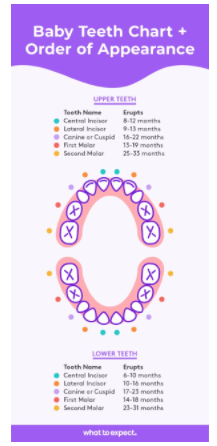
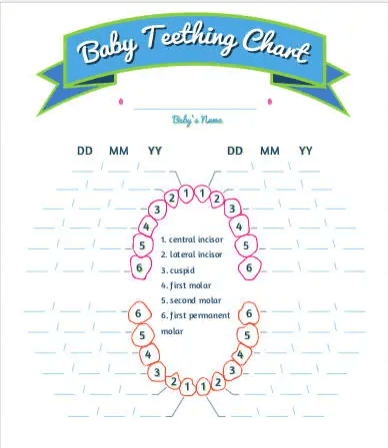
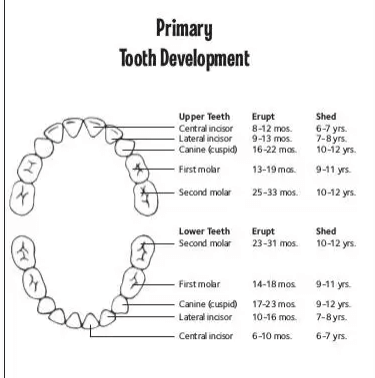


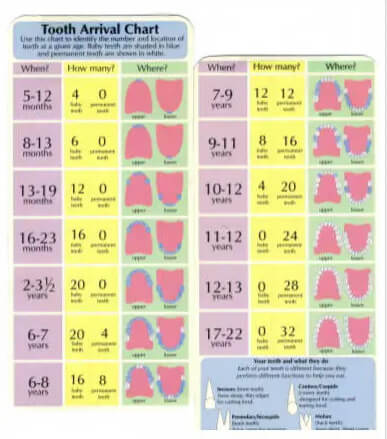
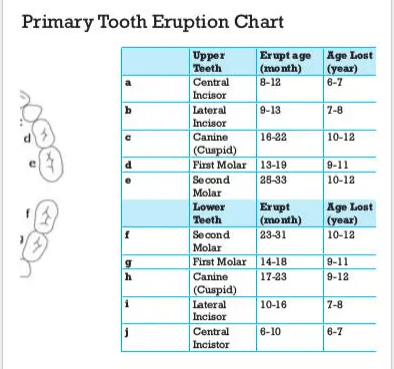
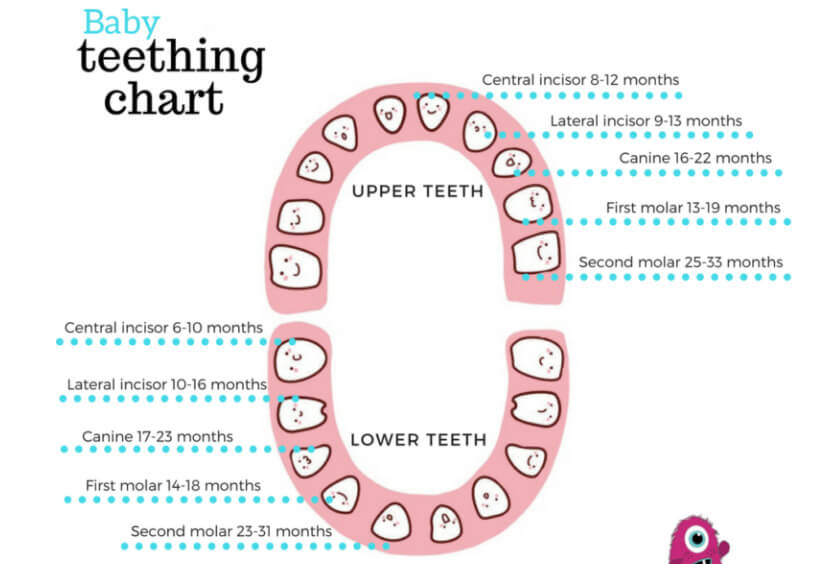
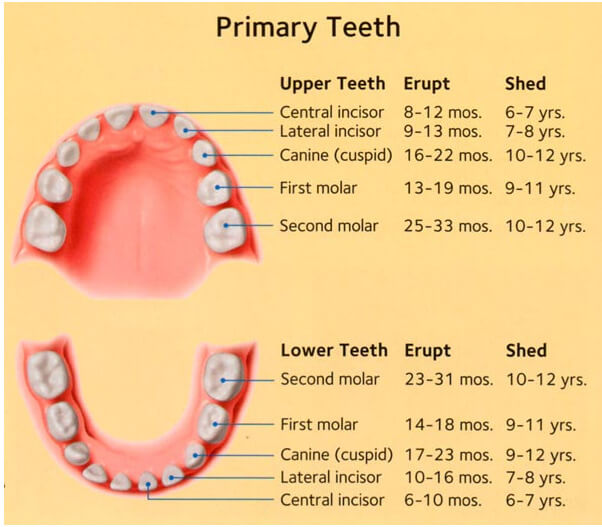

Understanding Baby Teething Chart
A teething chart will outline the type of teeth, position in the mouth, and emergence and fallout period (age). Ordinarily, babies will have 20 deciduous (primary) teeth; 10 on the lower jaw and 10 on the upper jaw. The different types of teeth are central incisors, lateral incisors, first molars, canines, and second molars.
Deciduous teeth will systematically erupt as the baby grows up to the age of 3. Ordinarily, the upper or lower incisors will be the first to emerge, followed by the lateral incisors, and then the first molars, followed by the canines.
The different types of teeth will emerge in pairs, one on each side of the upper or lower jaw, until all the deciduous teeth have erupted. Then, at around the age of six (6), the teeth start falling out to make way for the baby’s permanent teeth.
There are, therefore, two types of charts that parents need to be aware of–one for primary baby teeth and another for permanent teeth.
Below are some charts and information that has been derived for better understanding:
Deciduous teeth
Deciduous teeth, alternatively known as primary teeth, are the first set of teeth to appear in a baby’s mouth. The emergence of teeth is in pairs; one tooth appears on the right, and the other tooth appears on the left within the same jaw. Teeth eruption begins with the emergence of the central incisors on either jaw.
A teething chart gives an approximate age range for tooth eruptions, not the exact age. Below are charts that illustrate the eruption and fall of teeth in a baby:
Eruption and fallout of top teeth
| UPPER TEETH | ERUPT | SHED |
| Central incisor | 8-12 months | 6-7 years |
| Lateral incisor | 9-13 months | 7-8 years |
| Canine (cuspid) | 16-22 months | 10-12 years |
| First Molar | 13-19 months | 9-11 years |
| Second Molar | 25-33 months | 10-12 years |
Eruption and fallout of bottom teeth
| LOWER TEETH | ERUPT | SHED |
| Second molar | 23-31 months | 10-12 years |
| First molar | 14-18 months | 9-11 years |
| Canine (cuspid) | 17-23 months | 9-12 years |
| Lateral incisor | 10-16 months | 7-8 years |
| Central incisor | 6-10 months | 6-7 years |
The emergence of deciduous teeth begins with the eruption of the bottom central incisors, followed by the upper central incisors. They are then followed by the upper lateral incisors and then the lower lateral incisors. As the chart indicates, it is not uncommon for babies for the first molars to emerge before the lower lateral incisors.
The canine teeth then follow, and the second molars finalize the deciduous teeth development pattern by the time the baby is two and a half to three years old.
Permanent teeth
Once the baby sheds the teeth, and during the shedding, permanent teeth start to emerge. Below are teething charts of permanent teeth of kids aged six and above:
Eruption of top teeth
| UPPER TEETH | ERUPT |
| Central incisor | 7 to 8 years |
| Lateral incisor | 8 to 9 years |
| Canine (cuspid) | 11 to 12 years |
| First premolar (first bicuspid) | 10 to 11 years |
| Second premolar (second bicuspid) | 10 to 12 years |
| First molar | 6 to 7 years |
| Second molar | 12 to 13 years |
| Third molar (wisdom teeth) | 17 to 21 years |
Eruption of bottom teeth
| LOWER TEETH | ERUPT |
| Third molar (wisdom teeth) | 17 to 21 years |
| Second molar | 11 to 13 years |
| First molar | 6 to 7 years |
| Second premolar (second bicuspid) | 11 to 12 years |
| First premolar (first bicuspid) | 10 to 12 years |
| Canine (cuspid) | 9 to 10 years |
| Lateral incisor | 7 to 8 years |
| Central incisor | 6 to 7 years |
The teething chart shows that the first molars of babies will typically be the first set of teeth to emerge, with or before the central incisors. They are then followed by the lower canines, which are followed by the first and second premolars and/or upper canines.
The second molars then follow, and the emergence of the third molars finalizes the permanent tooth development pattern. By the age of 21, an individual should be having all 32 teeth.
Related: Free Baby Growth Charts (Weight and Height): 1 to 36 Months
Why do primary teeth fall out?
As the baby grows, their jaw and facial bones progressively grow and expand, thus creating spaces in between the primary teeth. This causes the loosening of the grip on the primary teeth, which fall out and consequently create space for the more prominent permanent teeth. This process begins after four years of age; therefore, a mixture of primary and permanent teeth will reside in the mouth.
Facts: Several facts are believed to be true regarding teething in babies. They include:
- The lower teeth emerge before the upper teeth
- On average, a baby erupts approximately four teeth every six months
- Teething occurs earlier in girls than in boys
- Teeth emerge in pairs in each jaw, one on each side of the jaw, that is, on the left and right side
- By the age of 2 to 3 years, all the primary teeth are expected to have already erupted.
- Deciduous or primary teeth are whiter and more diminutive than permanent teeth.
Total number of Teeth for Babies and Kids
As mentioned earlier in the chart, teething will usually start at the age of 6 months and proceed to 2 ½ to 3 years, when the baby is expected to have all 20 primary teeth. After that, babies will have all 20 primary teeth until they start to fall out at age 6 or 7. By the time the kid gets to 12 years old, they will have shed all their primary teeth and grown permanent ones.
Kids then grow additional teeth throughout their teenage years up to around 21 years old, when they are expected to have all 32 permanent teeth. However, some individuals can remain with baby teeth all through adulthood if there isn’t a permanent tooth replacement. These teeth are referred to as “retained primary teeth” in this situation.
Points to Remember
Dental and oral care are crucial for babies just as they are for adults, if not more. Parents should aim to ensure their babies grow up with healthy teeth free from cavities and other dental-related issues.
Usage of plain pacifier
Always use a plain pacifier if at all it is needed to keep the baby calm and quiet. Do not dip it in honey, as it may result in a type of poisoning known as botulism. Also, do not use sugar to compel the baby to use the pacifier.
Brush regularly
As indicated in the chart, teeth appear in the 8th month, so it is recommended that parents wipe their baby’s gums using a clean, wet washcloth and some water. They can also use a finger brush instead. Brushing of teeth should be introduced to babies as early as when teeth start appearing from the gum.
note
Brushing is recommended twice a day.
The second time should be after having their last meal and before taking their nap to inhibit bacteria from building up in the mouth during sleep.
Brushing should be done using a damp brush and making gentle circles on the front and back of all the baby’s teeth. A smear of toothpaste can be used even for babies under three years old. Make sure to use a toothbrush that suits the baby; it can either be manual or electric. A playful brush also helps get the baby actively involved in their oral hygiene at an early age.
Avoid sugary foods
Sugar is well known to cause tooth decay. Therefore, it is essential to avoid giving babies sugary drinks or snacks at an early age. These may result in dental cavities. It is recommended that babies aged one and below not have juice whatsoever.
However, if they must have a sugary drink such as fruit juice, babies can take a limit of 4 ounces of 100% fruit juice per day. Parents should check the constituents of processed foods to ensure they are not giving their babies sugary food without any knowledge.
Avoid using bottles
Babies should not be allowed to go to bed with a bottle of either breast milk or formula. Having the milk stay in their mouth without any activity going on in the mouth can result in tooth decay. Parents should also avoid giving fruit juice in a bottle at all costs.
Don’t use utensils
A baby should use their feeding items. Parents should avoid sharing spoons and other utensils with their babies to avoid transferring bacteria from their mouths into the baby’s mouth.
Use fluoride toothpaste
The American Dental Association recommends that fluoride toothpaste is safe, even for young children. The (AAP) American Academy of Pediatrics recommends parents introduce a smear (about the size of a rice grain) of fluoride toothpaste once the first tooth has erupted.
This is because ingestion of this amount of fluoride toothpaste has no adverse effects. The amount can be progressively increased over time until the baby can comfortably spit it out.
See a dentist
Parents are recommended to take their babies for a dental check-up after the baby turns 1 year old or erupts their first tooth, whichever comes first. It is always good to have a pediatrician/dentist examine the baby’s dental health in case of any underlying issues.
Frequently Asked Questions
Oral hygiene for primary teeth is essential for babies because of its long-term benefits, not just temporary ones. Therefore, caring for primary teeth is important because they create space for permanent teeth, help with the development of speech, and give the baby’s face a normal appearance.
In addition, oral care prevents decay, which would otherwise affect the baby’s nutrition by making chewing difficult and causing the baby to reject food. Oral care of primary teeth also helps maintain healthy gums, which are the foundation of permanent teeth.
Not necessarily because a baby’s first set of teeth is primarily used for biting on and mashing food, not chewing; chewing begins after molars have emerged, usually around the age of 2.
Babies aged six months and below do not need fluoride supplements. However, older babies may or may not require the supplements. Fluoride supplements are needed if the local water is non-fluorinated or if the baby only drinks bottled water that does not contain fluorine. It is always recommended that a pediatrician’s advice be sought before giving the baby fluoride supplements.
Teething can be painful or painless, depending on the situation. However, it can be painful and irritable due to the swelling and tendering of the gums just as the teeth emerge. Crying can therefore be an indication of teething in babies.
The number of teeth in a one-year-old baby will vary from one baby to another. Therefore, it is relatively common to find one-year-olds with as many as four teeth, eight teeth, or even no teeth at all.
The most common teething symptoms are excessive drooling, crying, the urge to chew on things, irritability, and disrupted eating and napping patterns.
Teething will often commence between the ages of 4 and 7 months. However, the 6th month is the most common age when a baby’s first tooth will erupt.

